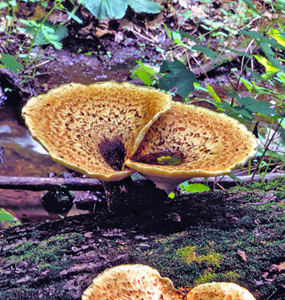Polyporus squamosus

Image Courtesy of Peter Katsaros
| Click to Enlarge |
| Click For Image Gallery |
|
Group of Fungi: Polypores Family: Polyporaceae Latin Name: Polyporus squamosus (Huds.) Fr Common Name: Dryad's Saddle Description: Fan-shaped to kidney-shaped or almost circular structure; cap 3–12 in (7.5–30 cm) across and 1/4–1 1/2 in (0.5–3.5 cm) thick, flat to somewhat depressed in the center, upper surface dingy white to pale yellow or pale brown, with concentrically arranged bands of blackish brown to reddish brown flat, overlapping scales, tough and leathery texture; spore-bearing surface white to cream at first but becoming pale yellow with age, pores large, angular, extending down the stalk; stalk off-center to lateral, 3/8–2 in (1–5 cm long) and 3/8–1 5/8 in (1–4 cm) thick, black at the base but otherwise colored like the upper surface of the cap; spores white in mass. Biological Role: Decomposer of wood but also can be considered as a pathogen when present on living trees. Habitat: On dead branches, fallen logs and stumps of broadleaf trees; solitary or occurring in groups, sometimes with overlapping fruiting bodies. Geographical Distribution: Widely distributed throughout eastern North America. Comments: This large and distinctive fungus is not likely to be overlooked in nature. The bands of dark flat scales on the upper surface of the cap make this species easy to identify, since there is nothing else quite like it in the forests of eastern North America. Fruiting bodies of Polyporus squamosus tend to be most common in the spring but are tough enough to persist in nature for a considerable period of time. The outer portion of the cap in young specimens is considered to be edible. |
| Go Back |